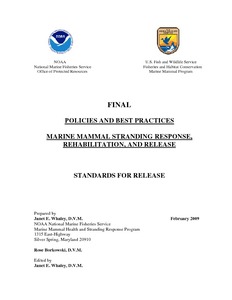| dc.contributor.author | Whaley, Janet E. | |
| dc.contributor.author | Borkowski, Rose | |
| dc.date.accessioned | 2018-08-27T20:47:15Z | |
| dc.date.available | 2018-08-27T20:47:15Z | |
| dc.date.issued | 2009 | |
| dc.identifier.citation | Whaley, Janet E. and Borowski, Rose (2009) Marine Mammal Response, Rehabilitation, and Release: standards for release. Silver Spring, MD, NOAA National Marine Fisheries Service Marine Mammal Health and Stranding Response Program, 114pp. DOI: http://dx.doi.org/10.25607/OBP-83 | en_US |
| dc.identifier.uri | http://hdl.handle.net/11329/501 | |
| dc.identifier.uri | http://dx.doi.org/10.25607/OBP-83 | |
| dc.description.abstract | Rescue, rehabilitation, and release of wild marine mammals is allowed for authorized individuals under listed conditions by the Marine Mammal Protection Act (MMPA) [16 U.S.C. 1379 § 109(h)]. Section 402(a) of Title IV of the MMPA specifically mandates that “The Secretary shall... provide guidance for determining at what point a rehabilitate d marine mammal is releasable to the wild” [16 U.S.C. 1421 §402(a)]. This document fulfills the statutory mandate and is not intended to replace marine mammal laws or regulations. In accordance with the MMPA, these guidelines were developed by the National Oceanic and Atmospheric Administration’s (NOAA) National Marine Fisheries Service (NMFS) and the U.S. Fish and Wildlife Service (FWS) in consultation with marine mammal experts through review and public comment on the 1997 draft NOAA Technical Memorandum “Release of Stranded Marine Mammals to the Wild: Background, Preparation, and Release Criteria.” Comments from the public review process and other outstanding issues were compile d by NMFS and FWS. The agencies consulted with experts in three areas: cetaceans, pinnipeds a nd sea otters, and manatees. The experts reviewed and discussed the public comments and provided individual recommendations. This current document encompasses revisions and updates to the 1997 draft and is titled differently. These guidelines provide an evaluative process to help determine if a stranded wild marine mammal, following a course of treatment and rehabilitation, is suitable for release to the wild. These guidelines describe “Release Categories” for rehabilitated marine mammals of each taxonomic group (i.e., cetaceans, pinnipeds, manatees, sea otters and polar bears). After completing a thorough assessment as prescribed, the release candidates are to be assigned to a Release Category as follows: Releasable , Conditionally Releasable, Conditionally Non-releasable (Manatees only) , and Non-releasable . This document establishes essential release criteria that trained experts should use to determine whether or not individual animals are healthy enough to release into the wild. | en_US |
| dc.language.iso | en | en_US |
| dc.publisher | NOAA National Marine Fisheries Service Marine Mammal Health and Stranding Response Program | en_US |
| dc.subject.other | Marine mammals | en_US |
| dc.subject.other | Strandings | en_US |
| dc.title | Best Practices for Marine Mammal Response, Rehabilitation and Release: standards for release. | en_US |
| dc.type | Report | en_US |
| dc.description.status | Published | en_US |
| dc.format.pages | 114pp. | en_US |
| dc.description.refereed | Refereed | en_US |
| dc.publisher.place | Silver Spring, MD | en_US |
| dc.subject.parameterDiscipline | Parameter Discipline::Biological oceanography::Birds, mammals and reptiles | en_US |
| dc.description.currentstatus | Current | en_US |
| dc.description.sdg | 14.2 | en_US |
| dc.description.eov | Marine turtles, birds, mammals abundance and distribution | en_US |
| dc.description.bptype | Best Practice | en_US |
| dc.description.bptype | Guide | en_US |
| obps.resourceurl.publisher | http://www.nmfs.noaa.gov/pr/pdfs/health/release_criteria.pdf | en_US |
 Repository of community practices in Ocean Research, Applications and Data/Information Management
Repository of community practices in Ocean Research, Applications and Data/Information Management
